| The statues of the “gods” from the Pantheon are now found in the Vatican Museum with the exception of the great statue of Jupiter, which has been modified, re-titled, and seated on a throne in St. Peter’s Basilica in Rome as St. Peter. Thousands of pilgrims kiss the foot of Jupiter while thinking it is the statue of Peter and have nearly worn it away. Notice the sun wheel above his head? Note also that the pattern on the wall behind the statue utilizes the symbol of Baal. | 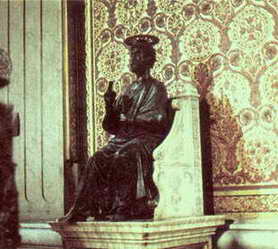 |
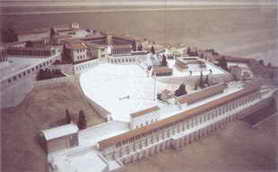 | Following the conquest of Mesopotamia by the Persians, the Babylonian priesthood fled to Pergamum in Asia Minor. Here they erected the Acropolis temples of Pergamum in honour of the Greek Pantheon, but continued to worship the Babylonian mystery god under the name of Saturnus. |
| Many of the Babylonian mysteries were preserved in the temple of Zeus at Pergamum and transferred to Rome in 133 B.C. when Attalus III died without an heir and bequeathed his kingdom to Rome. The penetration of the religion of Babylon became so general that Rome was called the “New Babylon.” | 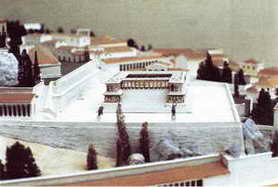 |
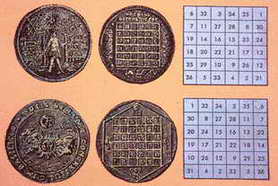 | The origin of the number 666. In 133 B.C. the Babylonian solar cult was bequeathed to Rome by Attalus III. There its symbols and forms were incorporated into the cult of Caesar and later into Roman Catholicism. Note that the numbers add up to 111 for each row, column and even the diagonals, with the grand total of 6 x 111 equalling 666 for each table. |
| Winged serpent spirit, signifying the soul of the departed (Egypt). It is very interesting that in ancient mythology, the serpent was universally the symbol of the sun. Sun worship and serpent worship began side by side. The sun was proclaimed to be the source of all fleshly life and the serpent the origin of all spiritual life. |  |
 | Winged serpent guardians, King Tut’s throne, Cairo, Egypt. The religion of the serpent has passed down from one occult priesthood to another all the way down through the years as man was scattered throughout the earth from the time of the Tower of Babel. Remember that sun and serpent worship began together. |
| Mayan serpent sun god coming out of the mouth of a dragon was used in connection with the Mayan sun god ‘Quetzalcoatl’ on the Island of Cozumel, 1000 A.D. What do they represent? Revelation 12:9 “And the great dragon was cast out, that old serpent, called the Devil, and Satan, which deceiveth the whole world: he was cast out into the earth…” | 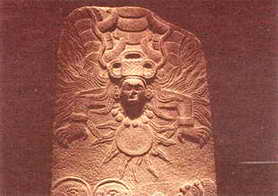 |
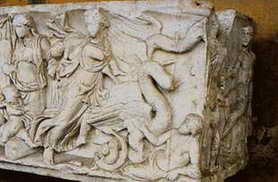 | Romans adopted the worship of the serpent as a symbol of power that carries the soul to heaven. In the Archaeological Museum in Rome, a sarcophagus of the dead has two serpents pulling a chariot taking these people to heaven. Rome also adopted this symbol of the serpent as the healer as have many countries. |
| Roman bath, in Bath, England. Notice the serpent as a symbol of healing. Even the United States has adopted the serpent called Aesculapius in the medical field. In Greece, this serpent was the god of drugs and medicines, i.e., a counterfeit healer. |  |
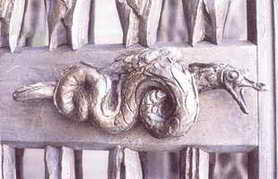 | Serpent door handle on the new St. Mary’s Cathedral in San Francisco, California. The serpent as we have already seen became the symbol of healing in many countries. It is hard to imagine a symbol that represents Satan on the door of a Cathedral. One would think they would have to know what the Bible says it represents. |
| Dragon on a large papal crest in the Vatican museum. Vatis = diviner, can = serpent. Vatican = The Divining Serpent. Knowing the meaning of the word Vatican no one will be surprised that the crest of the Vatican is “a serpent-dragon” The Bible says inRevelation 12:9 “the dragon, that old serpent, called the Devil, and Satan, which deceiveth the whole world…” | 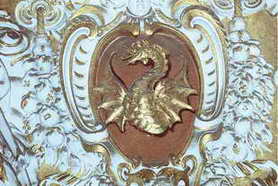 |
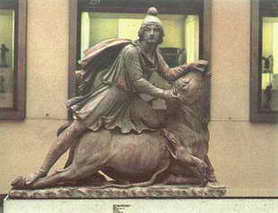 | The Persian sun god Mithra was widely accepted in the Roman world prior to Christianity. Sunday was dedicated to Mithra (lord), receiving the title of the “Lord’s Day” Mithraism had seven sacraments the same as the Catholic Church. The Eucharist hosts were signed with a cross, an ancient phallic symbol which originated in Egypt, and the Egyptian cross (the ankh) still shows the original form which included the female symbol. |
| The Pope enthroned under a canopy with astrological figures of the Zodiac in the Vatican Museum. The sign of Leo is directly above the Pope’s head. During the Dark Ages, the greatest astrologer of all times, Nostradamus had to be cautious of the Inquisition which he narrowly escaped several times. Yet that Church had knowledge of the stars and used astrology. |  |
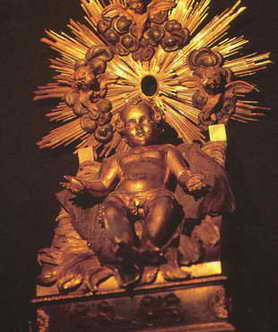 | Golden child in the Vatican treasury, like so many other images of the child in Catholic Churches, is reminiscent of the ancient worship of Tammuz as a child. Born on Dec. 25, he represented the rebirth of the sun. As a pagan god child, he was called “Baal-berith.” Pagan Anglo Saxons called Dec. 25 “Yule” Day, which is a Babylonian word for infant. Egyptians and Persians celebrated the birthday of their god on Dec. 25th. Other names applied to the sun god as a child are Mithras, Horus, Isvara, Deoius, Jupiter, Plutus, Ninus, Osiris, Dionysus, Bacchus, Iacchus, Adonis, Attis etc. All these myths of child worship originated from ancient Babylon with Semiramis and Nimrod. |
| Mother or Mary worship is the most powerful and emotional phenomenon in the Roman Catholic Church today. This mystic cult is given credence by the multitude of accounts about supernatural phenomena involving statues, apparitions and healings. Since Mary worship is found nowhere in the writings of the first Christians, it is evident that its origin is found in the universal adoration of the mother goddess all throughout paganism before the time of Christ. It was adopted into the rising Roman Church early in its history - some suggest after the 4th century A.D. | 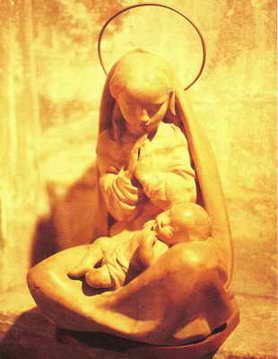 |
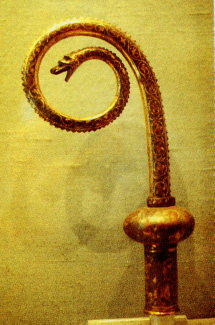 | Serpent crosiers were commonly carried by bishops and high Catholic Church officials in the Middle Ages. They claim that the crosier represents the shepherd’s crook, but it can be traced to the divining staff or augur of Pontifex Maximus of ancient Rome who inherited it from the priests of Babylon. It is unrealistic to assume that shepherds of nomadic existence would use wooden rods with handles like the one shown or anything like it. Common sense would have them use something straight and not entangle themselves with when having to fight off wild animals. Thinking about plays representing the birth of Jesus in Bethlehem, it is absolutely disgusting to see shepherds hold staffs other than straight wooden rods. |
| The pagan symbol representing male and female union. The wavy lines portray the female and were associated with the serpent, while the straight line is male and is representing the phallus. We find the same principles of male-female in the paganism of astrology, which is very much a religion of nature worship of which the sun and the moon are the predominant deities. The sun is usually the male and the moon the female (as Horus and Isis of Egypt, which originated from Semiramis and Nimrod her husband/son.) |  |
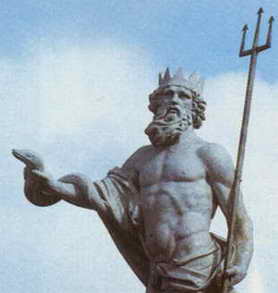 | Adad, Enlil, Baal, Neptune, Poseidon and other “gods” of storm and sea were depicted as carrying tridents. It was symbolic of lightning. Here Poseidon or Neptune, said to be ruler of the sea or underworld, holds the trident, which is traceable to the horned, hoofed sun god of Babylon who carried the trident or pitchfork. The trident is also a representation of the male-female symbol. |
| A cross on the altar of St. Paul’s Cathedral in London with four tridents in the Hindu fertility style. Some dispute that Roman Catholic Church leaders incorporated pagan Babylonian religious practices into the Catholic Church but even Catholic historians admit it. Cardinal Newman in his Development of Christian Doctrine, pages 372, 373 says that the Church incorporated many pagan religious practices into the Church. He claims that the Church sanctified them and that made it safe to bring these practices into the Church. | 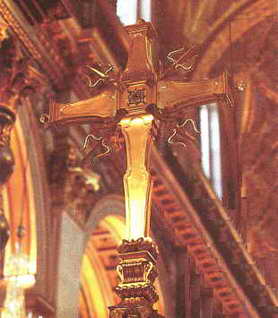 |
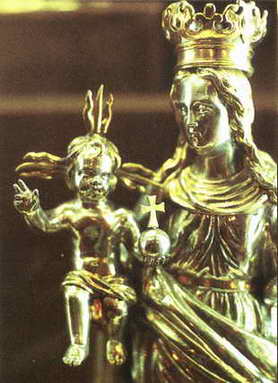 | A trident projecting from the head of baby Jesus on a Roman Catholic Madonna and child image. This in fact originally represented Semiramis and Nimrod her husband/son. See the origin of sun worship and Babylon. Also notice the hand how it is displayed with two fingers and thumb prominent, another way of symbolizing the trident, a Satanic hand sign, symbolic of occult powers, also used by high Church officials and priests in various blessings invoking the sign of the cross by motioning their right hand with two fingers and thumb casually extended. It is also found in freemasonry of which origins can be found in the Catholic Church. |
| The old statue of Jupiter with its occult blessing hand is now St. Peter in the Vatican. As stated earlier, the statues of the gods from the Roman Pantheon can now be found in the Vatican Museum with the exception of the great statue of Jupiter, which has been modified, re-titled, and seated on a throne in St. Peter’s Basilica in Rome as St. Peter. Thousands of pilgrims kiss the foot of Jupiter while thinking it is the statue of Peter and it has been nearly worn away from the many pilgrims who kiss paying homage. Notice the sun wheel above his head? You can also note also that the pattern on the wall behind the statue utilizes the symbol of Baal. | 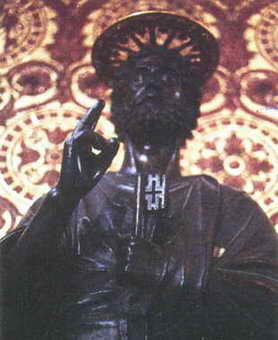 |
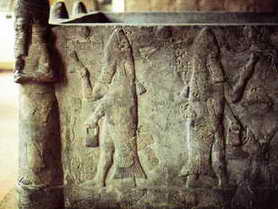 | Pagan priests as half fish sprinkling holy water on Assyrian temple laver in the Pergamum Museum of Berlin. One of the names of this god in Babylon and Phylistia was Dagon (dag=fish, on=sun). The most common ways of depicting Dagon are described by the archaeologist Layard, “The Head of the fish formed the mitre above that of a man, while its scaly, fish-like tail fell as a cloak behind, leaving the human limbs and feet exposed.” Layard’s Babylon & Nineveh, p.343 |
| Dagon the sun-fish god, again clearly displayed with fish attire and mitre. Note also the carvings and diagrams of Dagon priests and their fish head hats alongside the Pope with his similar fish head hat holding the crooked cross of Mithra. The carving on the left shows the Dagon priests sprinkling holy water and is taken from the above image. | 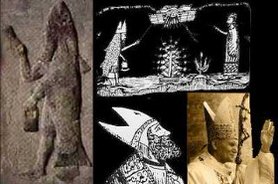 |
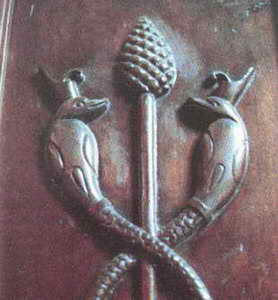 | This pine cone staff in the Egyptian Museum Turino, Italy is a symbol of the solar god Osiris and originated in Egypt where he was their messiah who died for his people and whose Mother, Isis, was worshipped as the Virgin Mother. Osiris was the Egyptian counterfeit of Jesus Christ. The pine cone on the tree of life, slowly ripens the conifer’s female seeds, and in the later stages the cone opens up to release its mature seeds. This process symbolizes the seeding effect on other people and culture together with the expansion of consciousness. |
| Assyrian winged god with pine cone, representing power of regeneration, traceable to Tammuz of Babylon. Most paganism in history is traceable back to Tammuz of Babylon. His mother Semiramis, was the first Virgin Mother predating the birth of Jesus Christ by over a 1000 years. The Catholic practice of making the Sign of the Cross originated in Babylon as people paid homage to their messiah, Tammuz, who “died for the good of his people.” There love was demonstrated for Tammuz by making the sign of the “T.” Satan has transferred this sign for Tammuz into the Catholic Church, as they think they are making the sign of the Christian cross. Tammuz was the Babylonian counterfeit of Jesus Christ. | 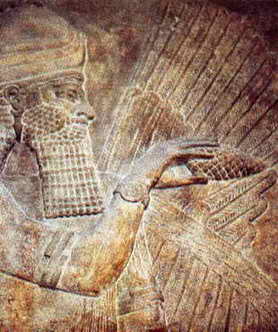 |
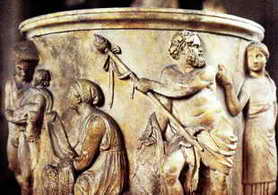 | Here the Greek god Dionysus carries the pine cone staff as a fertility symbol. Pine cones and pine cone staffs are very common on pagan statues and art symbols of fertility and regeneration. Children are always looked upon as extending the life of the human species. Therefore, it is predictable that the Pine Cone should be linked to the new life of the conception of children. |
| The largest pine cone in the world in the Court of the Pine Cone at the Vatican, Rome. Pagans have always coveted eternal life and have sought it by worshipping and revering many objects they find in Nature. The Roman Catholic Church utilizes the pine cone just as any good Pagan religion would do. This is further evidence that Roman Catholicism is more Pagan than Christian. In fact we could say that Roman Catholicism is counterfeit Christianity with Paganism as its beating heart. Pine cones are common in Roman Catholic architecture and sacred decorations. Note how the cone at the Vatican is immature and therefore unopened, just the way they want it! | 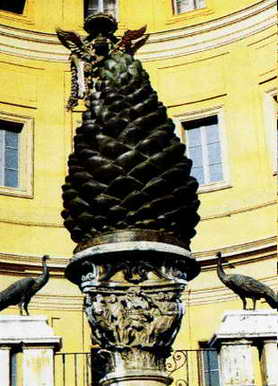 |
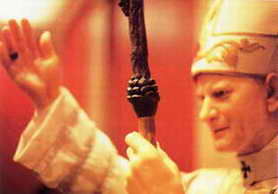 | The Pope carries a pine cone mounted on his staff, the ultimate pagan symbol. Since the ultimate goal of religion is the securing of eternal life, one should not be surprised that the Pope should be carrying the ultimate Pagan symbol of eternal life. |
| One of the most visible evidences that sun worship has continued under the name of Christianity. Look at the Pope with the symbol of “Baal” (sun worship) at the forefront of his mitre, which symbolizes the Dagon god. The symbol of the Dagon is in the form of a hat or mitre. Notice the open mouth of the fish at the top of the Pope’s mitre. The most famous temples of Dagon were at Gaza (Judges 16:21-30) and Ashdod (1 Samuel 5:3-7; 1Chronicles 10:10). Dagon was represented with the face and hands of a man and the lower half the body as the tail of a fish (1 Samuel 5:3-4). |  |
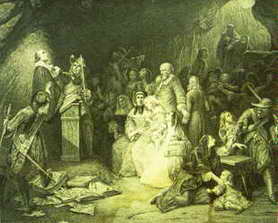 | Waldensian Christians worshiping in a cave while being attacked by Catholic soldiers. “The Papists took care after every mission of persecution to destroy as much of the Waldensian literature as possible.” Bompian, A Short History of the Italian Waldenses, p.56 “The inquisitors declare that the sign of a Vaudois (Waldenser) deemed worthy of death was that he followed Christ and sought to obey the Commandments of God.” H.C. Lea, History of the Inquisition of the Middle Ages, Vol.1 |
| Statue in the sanctuary of the Jesuit Church of Rome depicting the Church’s authority over kings and her destruction of what she considered Protestant heresy. On August 15, 1534, Ignatius Loyola established a new order of priests and brothers The Society of Jesus, better known today as the Jesuits. They were so evil they were banned in many countries. |  |
 | View of the plaza at the Vatican, also known as St. Peter’s square. The Papal palace is on the right edge. The large eight rayed sun wheel design symbolic of Ishtar is immediately noticeable. Look closely in the center of the wheel. What you see there is an obelisk, a genuine Egyptian obelisk shipped from Heliopolis to Rome by the Roman emperor Caligula. The obelisk is of course a phallic symbol but it also was used in sun worship. It is claimed that the wordobelisk literally means Baal’s shaft or Baal’s organ of reproduction. Source: Masonic and Occult Symbols Illustrated, by Dr. Cathy Burns, pg. 341. |
| Note around the obelisk at the center of the huge eight point sun wheel is a smaller four pointed sun wheel, the same symbol found on the altar stone in the temple of Baal in Hatzor.Leviticus 26:30 CJB “I will destroy your high places, cut down your pillars for sun-worship, and throw your carcasses on the carcasses of your idols; and I will detest you.” Ezekiel 6:4 AMP “Your altars shall be made desolate and your sun-pillars shall be broken in pieces, and I will cast down your slain before your idols.” | 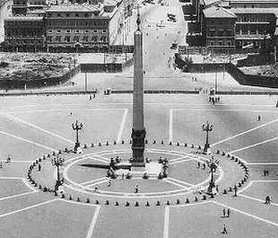 |
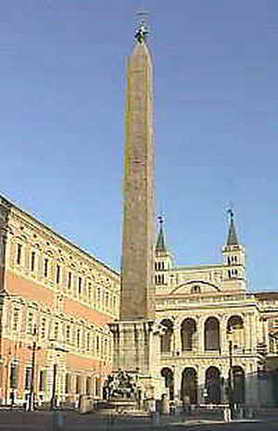 | The Egyptian obelisk that stands in the square of St. John Lateran (shown at left) is the largest in existence. Originally carved during the reign of Pharaoh Thutmoses III, it stood in the Temple of Amon in Thebes (Karnak), but was removed to Rome by emperor Constantius (A.D. 317-361) and placed in the Circus Maximus. In 1587 Pope Sixtus V unearthed the fallen, broken and long forgotten obelisk and had it repaired and placed in the Piazza S. Giovanni in Laterano. It is possible that Moses saw this very obelisk when he was in Egypt. Now this obelisk meant to honour the sun god stands beside what Catholics call the supreme “Mother of all Churches”, the official cathedra of the bishop of Rome, the Pope, which brings to mind the apostate Mother Church, Mystery Babylon the mother of harlots. |
| A tablet from the early 9th century B.C. which depicts the Babylonian sun god Shamash seated on the right, holding emblems of his authority, a staff and ring, and the king with two attendants on the left. In the centre on an altar is a large four point sun image with additional small wavy rays between the points. |  |
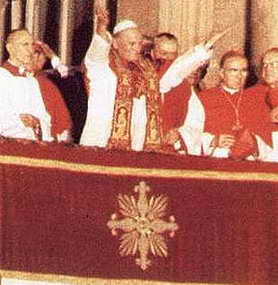 | Now look closely at the tapestry below John Paul II who is making his first public appearance as Pope in 1978. On the tapestry hung from the balcony, there is the symbol of Baal / Shamash very evident. Compare with the above image. In Hebrew, the word for sun is: 8121. shemesh, sheh’-mesh; from an unused root mean. to be brilliant; the sun; by impl. the east; fig. a ray, i.e. (arch.) a notched battlement:-- + east side (-ward), sun ([rising]), + west (-ward), window. |
| Look closely at the chest and around the neck of this Neo-Assyrian standing stone (stele/stela) dating from about 824-811 B.C., which depicts King Shamshi-Adad V. Note in particular the necklace the King is wearing. On it is what is called a Cross Pattée or Cross Formée. It was about twenty eight hundred years ago that this shape was symbolic of pagan sun worship. |  |
 | Now look closely at the Pope who wears a similar symbol around his neck on the Pallium, which the Pope also confers on selected bishops as an ornamental token of his favour, and it is also worn by archbishops and patriarchs as a symbol of their authority as a metropolitan, derived from unity with the Pope. Note also, that beneath John Paul’s Pallium there is a partially obscured diagonal cross, which mimics the diagonal bands below the Cross Pattée worn by the pagan king. The Pope also has a ring and staff of authority, remarkably similar to the depiction of the sun god Shamash. |
| Looking up into the dome of St. Peter’s you will notice the very obvious 16 ray sun wheel. Indeed the light from the sun streams into the centre hub of the dome making a genuine sun-lit sunburst image at the centre of the wheel. The Bible says these symbols were associated with sun worship, which is strongly condemned in scripture. So why are they so prevalent in the Roman Catholic Church if they are associated with paganism and apostasy and what became of sun worship? | 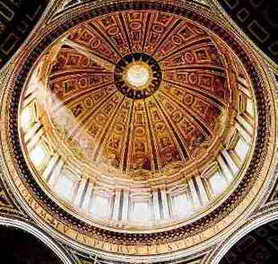 |
From sun and serpent worship 2000 B.C., to Sunday worship in the Church. Satan has infiltrated the Christian Church and most do not understand what has happened or the relevance. Sunday or “dies solis”, the day of the sun came from Satan worship and is his day. The Babylonian mystery religion went straight into the Church of Rome and God calls her mystery Babylon. She claims her mark to be her change of the fourth Commandment to the day of the sun.



















No comments:
Post a Comment